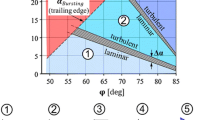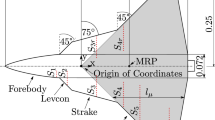Abstract
Lift and drag characteristics of delta wings with low swept angle and various sinusoidal leading edges (SLE) were investigated in a wind tunnel. Three amplitudes and three wavelengths of SLE were tested. It is revealed that, in comparison with the baseline case, when the leading-edge amplitude A⩽5%C (root chord length of a delta wing), the stall of the delta wing can be delayed without penalty on the maximum lift coefficient; meanwhile, the lift-to-drag ratio was kept nearly unchanged. These are beneficial to aircraft maneuverability and agility. Surface oil and hydrogen-bubble flow visualization experiments were further conducted to provide a general view of the underlying flow mechanism of SLE on delta wings. It was found that, for the flow over delta wing with SLE, vortices were generated from every crest of SLE, in contrast to the dual leading-edge vortex structure generated from the apex of the base wing. At high angle of attack, the breakdown of those vortices originating from the crests of SLE may provide additional turbulent kinetic energy to the flow, resulting in the increase of the flow reattachment region on the leeward side, therefore the stall can be delayed.
Similar content being viewed by others
References
Edel R K, Winn H E. Observations on underwater locomotion and flipper movement of the humpback whale Megaptera novaeangliae. Mar Biol, 1978, 48: 279–287
Fish F E, Battle J M. Hydrodynamic design of the humpback whale flipper. J Morphol, 1995, 225: 51–60
Watts P, Fish F E. The influence of passive, leading edge tubercles on wing performance. In: Proceedings of the Unmanned Untethered Submersible Technology (UUST 01), Autonomous Undersea Systems Institute, New Hampshire, 2001
Miklosovic D S, Murray M M, Howle L E, et al. Leading-edge tubercles delay stall on humpback whale (Megaptera novaeangliae) Flippers. Phys Fluids, 2004, 16(5): L39–L42
Miklosovic D S, Murray M M, Howle L E. Experimental evaluation of sinusoidal leading edges. J Aircraft, 2007, 44(4): 1404–1408
Johari H, Henoch C, Custodio D, et al. Effects of leading-edge protuberances on airfoil performance. AIAA J, 2007, 45: 2634–2642
van Nierop E A, Alben S, Brenner M P. How bumps on whale flippers delay stall: an aerodynamic model. Phys Rev Lett, 2008, 100: 054502
Hansen K L, Kelso R M, Dally B B. Performance variations of leading-edge tubercles for distinct airfoil profiles. AIAA J, 2011, 49(1): 185–194
Guerreiro J L E, Sousa J M M. Low-Reynolds-number effects in passive stall control using sinusoidal leading edges. AIAA J, 2012, 50(2): 461–469
Goruney T, Rockwell D. Flow past a delta wing with a sinusoidal leading edge: near-surface topology and flow structure. Exp Fluids, 2009, 57: 321–331
Taylor G S, Gursul I. Buffeting flows over a low-sweep delta-wing. AIAA J, 2004, 42(9): 1737–1745
Chen L, Wang J J. Numerical simulations of leading-edge vortex core axial velocity for flow over delta wings. Sci China Tech Sci, 2009, 52(7): 2029–2036
Wang J J, Zhang W. Experimental investigations on leading-edge vortex structures for flow over non-slender delta wings. Chin Phys Lett, 2008, 25(7): 2550–2553
Chen L, Wang J J, Zuo L X, et al. Influence of Reynolds number on vortex flow over a nonslender delta wing. AIAA J, 2010, 48: 2831–2839
Author information
Authors and Affiliations
Corresponding author
Rights and permissions
About this article
Cite this article
Chen, H., Pan, C. & Wang, J. Effects of sinusoidal leading edge on delta wing performance and mechanism. Sci. China Technol. Sci. 56, 772–779 (2013). https://doi.org/10.1007/s11431-013-5143-3
Received:
Accepted:
Published:
Issue Date:
DOI: https://doi.org/10.1007/s11431-013-5143-3




